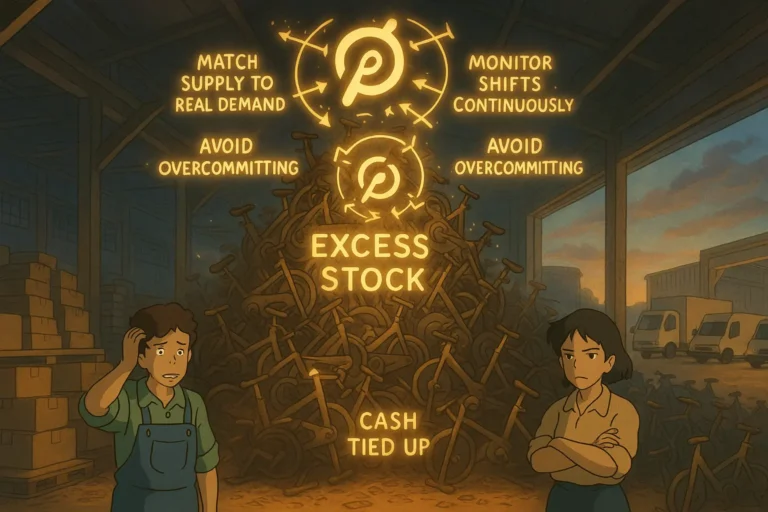
Demand volatility is not a new supply chain concept, although the last pandemic blew it out of proportion and exposed many African and global supply chains.
Every industry deals with demand volatility. And for various reasons. It could be seasonal, increased customer choice, competition, or some external crisis. Whatever the reason, it is always advisable to be prepared to handle it.
What is demand volatility?
Demand volatility is simply an unexpected variation in a product’s demand. Demand volatility can result from multiple factors, which we will discuss later in this article.
Although demand volatility is a common phenomenon, many African supply chains fail to prepare for it. This could be for various reasons, such as capacity, cost, or poor risk assessment.
When they are caught unprepared, it could lead to a loss of revenue. But more than that, it could lead to a loss of market share. This is because an increase in customer demand typically means the competition fails to meet supply.
It could also be for several other reasons, but the primary reason is a failure of the competition to meet up, which leads customers to flock to the next option. If that option fails to sustain their demands, it creates a bad experience for that customer. And they don’t forget easily.
How African supply chains can manage demand volatility
Demand volatility can be a pain if handled incorrectly or with the wrong strategy. There are some tips African supply chains can adopt to make the most of it.
1. Scenario planning
This is a process of evaluating the effect of different situations on the supply chain should they occur. They are “what if” questions that allow the supply chain to correctly gauge their response to uncomfortable situations should they occur.
Modern supply chains can utilize AI-based solutions for a more accurate or effective supply chain analysis and its ability to respond to crises. Scenario planning typically considers production capacity, inventory levels, and order cycle time.
When conducting scenario planning, supply chains come face to face with their shortcomings, allowing them to make better decisions or improve the overall process.
2. Collaboration
Modern supply chains can be such complex operations. And the challenges African supply chains face often make it difficult to handle demand volatility very well. One way businesses and supply chains on the continent can get around these is through collaboration.
Collaboration exposes supply chains to the resources, infrastructure, and expertise needed to meet customer demands at such short notice. With the right suppliers, especially market leaders, these supply chains will make light work of demand volatility.
However, the trick is finding and onboarding them before demand volatility hits. Searching for a reliable customer in the middle of the storm is counterproductive and does not benefit any supply chain.
3. Using AI for forecasting
Forecasting is a sure way for supply chains to predict the future. However, these can be complicated and prone to errors when the wrong factors or models are considered. This is where AI plays an active role.
Artificial intelligence solutions, such as predictive analytics, can help make this seamless, faster, and more accurate. With AI, there is a higher probability of catching demand volatility because it considers more relevant data than the average human can.
AI is one of the surest ways to tell the future. This, in turn, allows the supply chain to catch and better prepare for demand volatility.
4. Safety stock alerts
Safety stock serves as a buffer for supply chains. It is their last line of defence when battling demand volatility. However, it can be tricky to manage or control. There must be a balance for African supply chains to effectively use the safety stock concept as a tool to combat demand volatility.
You don’t want to have too much that costs your supply chain more than it is worth. At the same time, you do not want to have too small that it cannot hold off demand onslaught on the supply chain.
To achieve this, the supply chain has to strive for visibility and communication throughout the supply chain. They will also need the help of solutions such as retail analytics to ascertain customer behaviours better.
5. Cycle time reduction
Cycle time is lead time. It is the amount of time it takes to deliver an order to a client or customer. It is very important because customers increasingly want their order “now” and they are willing to take their business wherever they will get it.
However, in managing demand volatility, reducing order cycle time helps ensure that more orders are being processed, empowering the supply chain to handle demand volatility better.
You may want to optimize the warehouse, inventory, transportation, and order fulfilment process to achieve this.
6. Use the pre-order strategy
The pre-order strategy is often used to give the business or supply chain more time to meet demands without making it obvious to the customers. This strategy can work for African supply chains under pressure with demand volatility.
Take in as many orders as possible, then take out the time to sort and meet these orders as efficiently as possible. Pre-order is not a license to delay the customer’s order. However, it is only meant to provide you with room for flexibility.
7. Capacity increase
Many times, the issue with the supply chain’s ability to meet or manage demand volatility is the lack of capacity or capacity constraint. This makes the production process slow and negatively impacts order cycle time.
To tackle these, the supply chain may consider increasing its capacity and infrastructure across the supply chain. This is primarily on the production and inventory arm, but they can consider other areas of import.
Causes of demand volatility for African supply chains
Demand volatility works both ways. It could be too low demand or too high demand.
African supply chains are unique. There are certain causes that contribute to the demand volatility they face, such as:
- Economic Instability
- Seasonal Agricultural Trends
- Political Uncertainty
- Infrastructure Challenges
- Weather Conditions
- Cultural and Social Factors
- Infrastructure Development Projects
- Global Market Trends
- Population Growth and Urbanization
- Technological Advancements
- Trade Agreements and Policies
- Supply Chain Disruptions
- Exchange Rate Volatility
- Natural Resource Dependency
FAQs on managing demand volatility in African supply chains
𝗤𝟭: 𝗛𝗼𝘄 𝗱𝗼𝗲𝘀 𝗲𝗰𝗼𝗻𝗼𝗺𝗶𝗰 𝗶𝗻𝘀𝘁𝗮𝗯𝗶𝗹𝗶𝘁𝘆 𝗶𝗺𝗽𝗮𝗰𝘁 𝗱𝗲𝗺𝗮𝗻𝗱 𝘃𝗼𝗹𝗮𝘁𝗶𝗹𝗶𝘁𝘆 𝗶𝗻 𝗔𝗳𝗿𝗶𝗰𝗮?
Economic instability, such as inflation and currency devaluation, can impact consumer purchasing power, which can cause swings in the demand for different goods.
𝗤𝟮: 𝗪𝗵𝗶𝗰𝗵 𝗔𝗳𝗿𝗶𝗰𝗮𝗻 𝗶𝗻𝗱𝘂𝘀𝘁𝗿𝗶𝗲𝘀 𝗮𝗿𝗲 𝗽𝗮𝗿𝘁𝗶𝗰𝘂𝗹𝗮𝗿𝗹𝘆 𝘃𝘂𝗹𝗻𝗲𝗿𝗮𝗯𝗹𝗲 𝘁𝗼 𝗱𝗲𝗺𝗮𝗻𝗱 𝘃𝗼𝗹𝗮𝘁𝗶𝗹𝗶𝘁𝘆?
A larger degree of demand volatility may be experienced by industries strongly related to agriculture, commodities, and exports because of weather patterns and changes in the world market.
𝗤𝟯: 𝗛𝗼𝘄 𝗱𝗼𝗲𝘀 𝗱𝗲𝗺𝗮𝗻𝗱 𝘃𝗼𝗹𝗮𝘁𝗶𝗹𝗶𝘁𝘆 𝘀𝘁𝗲𝗺 𝗳𝗿𝗼𝗺 𝗽𝗼𝗹𝗶𝘁𝗶𝗰𝗮𝗹 𝘂𝗻𝗰𝗲𝗿𝘁𝗮𝗶𝗻𝘁𝘆?
Elections, governmental policy changes, and political unrest can all lead to uncertainty, which lowers consumer confidence and affects consumer purchasing decisions.
Conclusion
Although demand volatility is common for many industries and African supply chains, it can escalate into a real problem when not handled properly. To effectively do this, supply chains must invest in preventive measures or strategies, as discussed in the article. This way, they are better prepared, and the supply chain can flourish.
Countries:: Nigeria, Ethiopia, Ghana, Sierre Leone, Benin, Burkina Faso, Cote d’Ivoire, Togo, South Africa, Mozambique, Egypt, Niger, Senegal, Tanzania, Madagascar, and Cameroun.

Obinabo Tochukwu Tabansi is a supply chain digital writer (Content writer & Ghostwriter) helping professionals and business owners across Africa learn from real-world supply chain wins and setbacks and apply proven strategies to their own operations. He also crafts social content for logistics and supply chain companies, turning their solutions and insights into engaging posts that drive visibility and trust.








